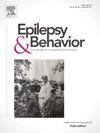How do anxiety, depression, and stigma affect quality of life in people with epilepsy?
IF 2.3
3区 医学
Q2 BEHAVIORAL SCIENCES
引用次数: 0
Abstract
Background
Anxiety, depression, and stigma can significantly affect the quality of life of people with epilepsy. This study was carried out to determine the relationship between these factors.
Method
The study was conducted with 325 people with epilepsy admitted to the neurology outpatient clinic of a training and research hospital in Istanbul, Türkiye. Data were collected using a General Information Form, the Depression in Neurological Disorders Scale-Epilepsy (NDDI-E), Generalized Anxiety Disorder-7 Scale (GAD-7), Epilepsy Self-Stigma Scale (ESSS), and Quality of Life in Epilepsy Scale (QOLIE-31). Data were analyzed using the Student’s t-test, one-way ANOVA, Pearson correlation, and multiple linear regression test.
Results
Of the included patients, 60.9 % were female, 61.5 % were married, and 84.3 % had generalized seizures. The mean anxiety score was 16.80 ± 6.13, and 13.5 % of patients had mild anxiety, 27.7 % had moderate anxiety, and 58.8 % had severe anxiety. The mean depression score was 14.07 ± 3.58, and 39.7 % of the patients were at risk for depression. The mean total score for stigma was 14.29 ± 5.67, and the mean total score of the quality of life scale was 47.54 ± 11.36. Quality of life decreased with increasing levels of depression (r = -0.418; p < 0.001), anxiety (r = -0.292; p < 0.001), and stigma (r = -0.224; p < 0.001). Depression, anxiety, stigma, and seizure frequency explained 25 % of the total variance in quality of life.
Conclusion
There was a negative correlation between anxiety, depression, stigma, and quality of life. These factors, as well as seizure frequency, were statistically significant predictors of quality of life in people with epilepsy.
焦虑、抑郁和病耻感如何影响癫痫患者的生活质量?
背景焦虑、抑郁和耻辱感会显著影响癫痫患者的生活质量。这项研究是为了确定这些因素之间的关系。方法本研究在土耳其伊斯坦布尔一家培训和研究医院神经内科门诊收治的325例癫痫患者中进行。使用一般信息表、神经障碍抑郁量表-癫痫(NDDI-E)、广泛性焦虑障碍-7量表(GAD-7)、癫痫自我耻辱量表(ESSS)和癫痫生活质量量表(QOLIE-31)收集数据。数据分析采用学生t检验、单因素方差分析、Pearson相关和多元线性回归检验。结果60.9%为女性,61.5%为已婚,84.3%为全身性癫痫发作。平均焦虑评分为16.80±6.13分,其中13.5%为轻度焦虑,27.7%为中度焦虑,58.8%为重度焦虑。平均抑郁评分为14.07±3.58分,有抑郁危险的患者占39.7%。病耻感平均总分为14.29±5.67分,生活质量量表平均总分为47.54±11.36分。生活质量随抑郁程度的增加而下降(r = -0.418;p & lt;0.001),焦虑(r = -0.292;p & lt;0.001),柱头(r = -0.224;p & lt;0.001)。抑郁、焦虑、病耻感和发作频率解释了生活质量总差异的25%。结论焦虑、抑郁、病耻感与生活质量呈负相关。这些因素,以及癫痫发作频率,在统计上是癫痫患者生活质量的显著预测因素。
本文章由计算机程序翻译,如有差异,请以英文原文为准。
求助全文
约1分钟内获得全文
求助全文
来源期刊

Epilepsy & Behavior
医学-行为科学
CiteScore
5.40
自引率
15.40%
发文量
385
审稿时长
43 days
期刊介绍:
Epilepsy & Behavior is the fastest-growing international journal uniquely devoted to the rapid dissemination of the most current information available on the behavioral aspects of seizures and epilepsy.
Epilepsy & Behavior presents original peer-reviewed articles based on laboratory and clinical research. Topics are drawn from a variety of fields, including clinical neurology, neurosurgery, neuropsychiatry, neuropsychology, neurophysiology, neuropharmacology, and neuroimaging.
From September 2012 Epilepsy & Behavior stopped accepting Case Reports for publication in the journal. From this date authors who submit to Epilepsy & Behavior will be offered a transfer or asked to resubmit their Case Reports to its new sister journal, Epilepsy & Behavior Case Reports.
 求助内容:
求助内容: 应助结果提醒方式:
应助结果提醒方式:


